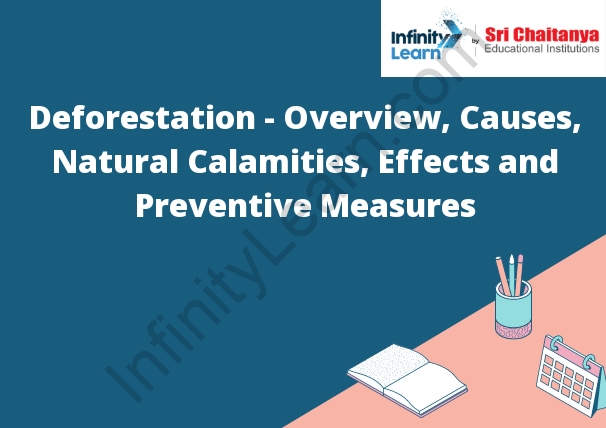Table of Contents
What is Deforestation – An Overview
Deforestation is the conversion of a forested area to land that is not forested. Deforestation can involve the natural loss of trees, as well as the potential destruction of forests due to the practices of people.

Importance of Forests
Forests are important because they provide many ecological services that are essential to the environment and human well-being. Forests regulate the climate, protect water resources, provide food and shelter for animals, and offer opportunities for recreation and tourism. They also play an important role in the global economy, supplying lumber, paper, and other forest products.
What is the Cause of Deforestation?
The main causes of deforestation are agricultural expansion, wood extraction, infrastructure development, and land conversion for other uses.
Human Activities
- There are a variety of human activities that can impact the environment. Some of the most common activities that can have a negative impact on the environment include deforestation, mining, and pollution.
- Deforestation occurs when forests are cleared for other purposes such as agriculture, mining, or development. When forests are cleared, the trees are often chopped down and the land is cleared for other purposes. This can lead to a loss of habitat for animals, a loss of oxygen, and a loss of carbon dioxide storage.
- Mining occurs when companies extract valuable resources from the earth. This can include extracting coal, oil, or minerals. Mining can have a negative impact on the environment because it can lead to the destruction of habitats, the release of pollutants into the air and water, and the depletion of resources.
- Pollution occurs when harmful substances are released into the environment. This can include emissions from factories, the runoff of pollutants from agricultural land, and the discharge of wastewater from cities. Pollution can have a variety of negative effects on the environment, including the destruction of habitats, the poisoning of wildlife, and the depletion of resources.
Natural Calamities
There are a number of natural calamities which can affect people and their property.
Some natural calamities are:
• Flooding
• Drought
• Earthquakes
• Tsunamis
• Tornadoes
• Hurricanes
• Volcanoes
What is the Effect of Deforestation?
Deforestation is the removal of forests, by whatever means. Deforestation has many effects on the environment.
Deforestation and the Water Cycle
Deforestation disturbs the water cycle by removing trees that help to regulate rainfall and groundwater. Deforestation can also lead to soil erosion, which can contaminate water supplies with sediment and pollutants.
Chipko Movement
- The Chipko Movement was an environmental movement in India that began in the 1970s and lasted until the early 1990s. The name “Chipko” comes from the Hindi word for “stick” or “to cling” and refers to the practice of hugging trees to prevent them from being cut down.
- The Chipko Movement began in the state of Uttarakhand, in the Himalayan foothills, in the early 1970s. At the time, the state was experiencing rapid deforestation as a result of the timber industry. In 1973, a group of women in the village of Reni decided to start hugging trees to prevent them from being cut down. The movement quickly spread to other villages in the area, and by the late 1970s, it had become a nationwide movement.
- The Chipko Movement was successful in stopping the deforestation of the Himalayan foothills. However, it was not able to halt the larger trend of deforestation in India.
Deforestation and Clearcutting
- Deforestation is the removal of forests, by whatever means. Clearcutting is a specific type of deforestation where all the trees in an area are cut down, regardless of their age or size.
- Deforestation and clearcutting are major causes of climate change. Trees absorb carbon dioxide from the atmosphere and release oxygen. When they are removed, the carbon dioxide they have absorbed is released back into the atmosphere, contributing to climate change.
- Deforestation and clearcutting also cause habitat loss, which can lead to the extinction of plant and animal species. Forests provide shelter and food for many animals, and when they are destroyed, the animals lose their homes and their sources of food.
- Deforestation and clearcutting also contribute to soil erosion. The loss of trees and vegetation leaves the soil exposed to the wind and rain, which can cause it to be washed away. This can lead to the formation of deserts and other ecological problems.
Deforestation Facts
1. Deforestation is the removal of forests, by whatever means.
2. Deforestation can refer to the natural loss of forests, as well as the potential destruction of forests due to the practices of people.
3. Deforestation has many causes, including people cutting down trees for lumber, for firewood, or to clear land for agriculture or other development.
4. Deforestation can also be caused by wildfires, or by the effects of climate change, such as drought.
5. Deforestation can have a number of negative consequences, including the loss of biodiversity, the loss of important carbon sinks, and the increased vulnerability to climate change.
6. The loss of forests can also have a negative impact on local and global economies, and on the quality of life of people in the affected areas.
7. There are a number of ways to combat deforestation, including enforcing regulations that protect forests, promoting sustainable forestry practices, and providing financial and technical assistance to local communities to help them conserve their forests.









